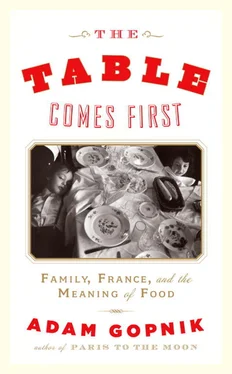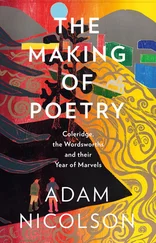The next plate was by Guy Savoy, one of his classics: an artichoke soup with black truffle and a brioche. (I was so hungry that I ate the brioche first.) “This is a classic plate,” Benedict said seriously. “But it is not quite as perfect as it is at his place, where the quality of the bouillon is better. Still—it is beyond complaint.” And it was, too: pungent and rich by turns. However, we had had two plates, and one turned on white truffles and the next on black, and though doubtless Ferran Adrià and René Redzepi use truffles when they want to, in neither’s cooking is the truffle ever the point, the climax, the concluding phrase.
All the wines—save one good Oregon Pinot Noir—were French, and they kept the evening going. “Except explain to me,” Benedict said, “why in America I am always served red wines that are ten degrees too hot, and white wines that are ten degrees too cold?” It was true: red wines, even Burgundies, in America tend not to be served at cave temperatures but at room temperatures, and they get soupy and too obviously alcoholic tasting, instead of being neatly gripped by the proper bouquet of smoke and dried fruits, in the process. “It is part of the predicament—the meaning of room temperature has changed so much from the nineteenth century,” he commented. We agreed that we liked our champagne, at least nonvintage champagne, very cold indeed, and we began to talk about the best champagnes we had drunk.
Benedict furrowed his brow again. “Well, a great Salon. Or perhaps a Winston Churchill Pol Roger.” This was the great prime minister’s favorite, and, despite the recent vintage of its name, it really is great. (Though, to be sure, most of the grandes marques of champagne—Dom Pérignon and Grand Siècle and so on—despite the antiqued bottles they often come in, are actually quite new, in the wine scheme of things, usually dating from after the Second World War.)
“I recall,” he said, “I recall a plate that one of the Troisgros brothers prepared for me once to go along with a bottle of the Churchill cuvée. He took a plate of scallops, coquilles Saint-Jacques , and then minced them, and turned them into a gently adhering ball, with raw black truffles adhering to the outside!” His excitement was manifest and contagious; he turned toward me as he spoke. “Then he poured a boiling, a truly boiling, reduction of asparagus! My God! It was served with a white Hermitage. My God! Perhaps it was the single best thing I’ve ever eaten.”
He shook his head, and I sensed the mix of remembered delight, nostalgia, and continuing sense of impasse that such memories would set off in a great French eater in this day. It was great, it was simple—too simple, probably, to be kept on a three-star menu—and it… led nowhere. It was an announcement about ingredients, produce, more than it was a new idea about cooking. Delicious, but not driven. It wasn’t that it was too simple to be praised; it’s that it was too elemental to become essential. Boiling broth and raw scallops was, in the day of complex illusionistic desserts and freeze-dried foams, like a beautiful tune played on a recorder: it might be more beautiful than anything made in an Auto-Tune mix, but you couldn’t really call it modern.
There was a fancy, heavy grilled aubergine by Ducasse, which seemed to both of us typical of Ducasse’s cooking: complex in statement and lacking in point. The main course, prepared—“prepared,” of course, more by decree than work—by the New York interloper Jean-Georges Vongerichten, was a rack of lamb with a hyper-hot sweet-and-sour Chinese glaze. We agreed that it was good, but so essentially Asian that it didn’t point a new way as much as surrender the field.
“There are no new restaurateurs in Paris,” Benedict concluded gloomily. “We have star chefs in three-star temples, each sunning himself in the light of his own name—but it is a food spectacle, not a food culture.” Not a food scene, I thought, and I explained to him what I meant, a little laboriously. “No real magazines, no real food plates… no wonder the next generation looks outside France for the future.” He shrugged. “Did I tell you about the butter I had in Montenegro? Serbian butter!”
No American or British eater would eat with such philosophical aplomb, with such innocent, unwatchful enthusiasm or with such an unfussy, reliable, vigilant feeling for all the details, long ago acquired—the temperature of a wine, the taste of a butter, the placement of a plate. It was not the dreary fussing to get it “right” of the anxious new eater—that nose-sniffing, brow-creasing, glass-swirling show—but a wry French sense of order and irony. French civilization has a taste for excessive order, and then an ironic sense about its own taste. (Italians have the ironic sense and Germans the excessive order, but neither has both together.)
French food persisted as a civilization after it was finished as a form. I loved the civilization so much that I would take it, so to speak, on an empty plate. But I would rather have the form and the civilization to go with it, and don’t see why we can’t. But Benedict knew that Brillat-Savarin’s tradition was being endangered by its own heirs, and when he talked about the best butter, he talked about a table in Montenegro. Without his saying so, it was plain to me, by the lift of an eyebrow and a benevolent shrug of the shoulder, that he regarded the Fooding folks as a bit silly and self-promoting—but it was also plain (by the droop of the eye and a sigh of the mind) that he knew that what they said was mostly true.
The ongoing insularity of French food, however defensive it may make a Francophile, is the real target of the Fooding movement. Their program is largely negative; what we don’t want is more of this, or This. What they do want is… whatever else there may be.
Doing some research in the French papers, I discovered the same puzzlement that I had had about Le Fooding. One magazine interviewer commented to Cammas and Rubin, “I don’t see what, exactly, in Le Fooding is revolutionary or even original—you’re searching for good little restaurants that aren’t too expensive. Where’s the novelty in that?” For that matter, a similar complaint about the conservatism of French cooking was at the heart of the nouvelle-cuisine revolution back in the seventies; its version of the Fooding guide was the Gault Millau guide of Henri Gault and Christian Millau.
Nor were the cooks who were being touted by Le Fooding for challenging the paradigm in any real way revolutionary. Le Comptoir, La Régalade—perfectly nice places, but not wildly imaginative. And, anyway, it seemed to me, back in Paris for July, that the new crisis in cooking looked about the same as the old—wonderful food, wonderful rooms, all passé by New York or London standards—and, surely, if the same crisis continues for decades it is no longer a crisis but merely a condition. It was a cheering thought. The real absence in France was not of good food but of what might be called think food—places like elBulli, or like Fergus Henderson’s St. John, where the food is devoted to an idea, whether of molecular transformations or of whole-beast eating. And, past a certain point, I realized that the absence of think food was not an absence that truly, in my heart, I regretted. Not everything has to evolve. There are enough ideas in life without having them all on your plate.
* * *
Nonetheless, I decided to continue my research. Another member of the Fooding team, Marine Bidaud, met me for lunch at L’Ami Jean, on a quiet side street near the Eiffel Tower. Where Zoé had been an embodiment of fifties French beauty, elegant and tense, Marine was more in the line of the young Bardot. She coolly explained that her values derived from her upbringing in the South of France, where her family still gathered around the table, and that she loved L’Ami Jean because it put her in mind of that tradition. She turned out to be an ex–art historian, who had done research on, among other things, Courbet’s great gynecological picture The Origin of the World . I picked at the charcuterie as we spoke. (I mention the glamour of the Fooding officials only because it is so atypical of the old French dispensation. Gourmands in the past were always middle-aged men with napkins tucked under their chins, or perhaps insolent thirty-somethings, like Gault and Millau, and never beautiful young women—or men either, for that matter. I pressed Alexandre about the astonishing glamour of the Fooding-istes, and he admitted that it was somewhat purposeful to have a staff that gave eating a more alluring aura than was always the norm in France.)
Читать дальше












